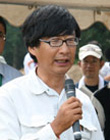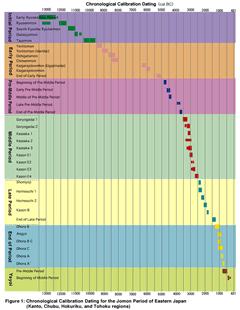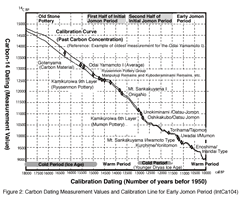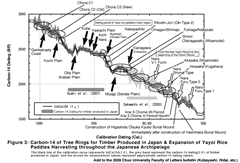Top>Research>New Archaeology Through Carbon Dating
 Index
Index

Kenichi Kobayashi [Profile]
Education course
New Archaeology Through Carbon Dating
Kenichi Kobayashi
Associate Professor of Archaeology, Faculty of Letters, Chuo University
Jomon Period Dating
In recent years, with carbon dating providing precise dating methods using AMS (accelerator mass spectroscopy), archaeology has taken a new position by achieving remarkable technological advances in both hardware and software. By examining over 2000 specimens of excavated carbonized extraneous matter on Jomon Period pottery, and dwellings found mainly in Japan, I have been able to estimate the actual age of Jomon and Yayoi Period pottery, order them chronologically and draw up a timeline. (Fig.1) With numerous forms of chronological research, the fine, relative sequencing of Jomon pottery, not seen anywhere else on earth, becomes clear and the results of carbon dating reveal no inconsistencies with the pottery timeline. This proves that we have been able to put in order Japan's detailed pottery history with considerable accuracy. With this, we found out that we also have room to investigate dates concerning vertical relationships between the regions such as relationships between the Kanto and Tohoku regions, which have produced conflicting theories in pottery research until now.
This isn't just simple progression in measurement technology. Compared with tree-ring dating, we have been able to make more precise date estimates with conclusive measurements of extraneous matter from pottery in perfunctory inspections, and by measuring many specimens while giving them archaeological relevance, it is possible for us to begin to tackle archaeological topics we haven't understood in the past.
Carbon dating research gives us new clues when investigating changes in pottery, and the rise and fall of communities at the excavated ruins. The rate at which pottery changes its form is presumed to be once a generation, and looking at the results when Jomon pottery is broken down into each form, we can see estimates in style changes ranging between 20 and 80 years. The rate of change has become clearer depending on era and region.
The Earliest Pottery Period
One outcome from chronological research lies in the time at the beginning of the Jomon Period. Through recent carbon dating research, it is certain that the beginnings of pottery in Japan date back to more than 15,500 years ago. (Fig.2) Through carbon dating of extraneous matter, it is possible that the oldest pattern-less pottery, found in the remains of Odai Yamamoto I Site in Aomori Prefecture, dates back 15,800 years, and as a definite example of testing, can be rated as the discovery of one the oldest pottery artifacts in the world. A sample of Ryusenmon Pottery Phase I at Gotenyama remains in Tokyo dates back 15,000 years, and then Ryusenmon Pottery spread all over Japan.
The era more than 15,000 years ago, when pottery first appeared, dates back to the glacial period. Because of this, changes in flora and fauna would lead to new ways of living within the Jomon Period, requiring us to rethink the theories we have come up with so far. The glacial period discovery in the beginning of Japan's Jomon Period displays a unique change in human history, even on a worldwide level. The beginning of the Jomon Period poses quite a large question.
Yayoi Rice Paddies / Hashihaka Kofun Period
I would like to touch upon research in a new area. A problem going back to the start of the Yayoi Period that even stirred up controversy in the media. The 500 year Yayoi Period antithesis, published in May 2003 by a research group centered on the National Museum of Japanese History, was introduced by carbon dated extraneous matter from pottery of the early Yayoi Period (the era in which rice paddies were first developed in Kitakyushu), and still causes great debate in the archaeological world today. The group, including myself, examined countless numbers of pottery specimens from the same period as the first rice paddies in Kitakyushu, pottery from the preceding late Jomon Period, and extraneous matter from the early and mid-Yayoi Period. In 2009, in regards to the age of Hashihaka Kofun in Sakurai City, Nara Prefecture, along with dating of specimens excavated at other burial mounds in Sakurai, the most logical result for the timing of the era preceding the construction of the Hashihaka Kofun points to the mid-third century. By making calculations based on calibration curves using Japanese tree-ring sample, we were able to make precise estimates of the dates. (Fig.3)
The era surrounding the Yayoi Period and beginning of the Kofun period is stirring up a large debate in archaeological circles. In any event, carbon dating has, without doubt, become indispensable to archaeological research.
Irregularities in the Time Span of the Jomon Period
At present, most effort is being put into research to construct a clear image of Jomon Period villages by accumulating age dating results. Representative of the mid-Jomon Period in East Japan is the loop-village, but no more than 100-300 dwellings remain. Opinions among researchers greatly differ into how many dwellings made up the village at one time, whether it existed continuously, or if it was built in a stop-start manner over time. Opinions on the same village remains range from 100 dwellings over a certain period to 2. This is because the lifespan of the houses and intervals between rebuilding is unclear. The aim of our research is to find definite answers through age dating specimens of numerous generations, ranging from pit constructions to buried artifacts, and remains of rebuilt dwellings. To achieve this we need to look for examples from each stage of housing during excavations.
Using Society for the Promotion of Science scientific research funds and designated research funds from Chuo University, excavations have been taking place on layered pit-dwellings from the mid-Jomon Period in the Ohinohara remains in Sagami City, Kanagawa Prefecture since 2008. Through these excavations we are making detailed records of what is unearthed, as well as collecting samples for dating. By age dating the unearthed specimens in the housing settlements (determining the time of construction, rebuilding, and ruin), we will conduct research to allow us to reconstruct movements within the village at that time. While we are still progressing at the research stage here, at a two-fireplace dwelling in the ruins at Fukimashima Prefecture's Idenohara, the results of dating more than 50 relics from one house have revealed buried objects from a period spanning over 300 years. On the other hand, datings from 9 houses in multi-layered settlements, previously studied in Tokyo's Ohashi remains, are estimated to have been rebuilt at an average interval of 13 years. With the accumulation of this kind of data, we are getting closer to producing a realistic image of the diverse village lifestyles in the Jomon Period.
By promoting the above age dating research, we are not simply trying to uncover the actual dates of each period, but this research will also lead to the introduction of a new archaeological viewpoint. Chuo University's archaeological research is right at the forefront of this new archaeology.
- Kenichi Kobayashi
Associate Professor of Archaeology, Faculty of Letters, Chuo University - Born in 1960 in Kanagawa Prefecture. Majored in ethno-archaeology at Keio University. Earned his doctorate at the Graduate University for Advanced Studies. After receiving his doctorate (literature) (Graduate University for Advanced Studies, 2003) he spent time at the on-campus archaeological research lab at Keio University's Fujisawa Campus, Research Society of Ohashi Remains of Meguro Ward, Tokyo, Center For Archaeological Research of University of Kanazawa, and as assistant professor at the National Museum of Japanese History. Currently working as associate professor at Faculty of Letters, Chuo University. (Major: Japanese History).
Kenichi Kobayashi Homepage
- Research Activities as a Member of Research Fellowship for Young Scientists (DC1), Japan Society for the Promotion of Science (JSPS) Shuma Tsurumi
- Important Factors for Innovation in Payment Services Nobuhiko Sugiura
- Beyond the Concepts of Fellow Citizens and Foreigners— To Achieve SDGs Goal 10 “Reduce Inequality Within and Among Countries” Rika Lee
- Diary of Struggles in Cambodia Fumie Fukuoka
- How Can We Measure Learning Ability?
—Analysis of a Competency Self-Assessment Questionnaire— Yu Saito / Yoko Neha - The Making of the Movie Kirakira Megane











